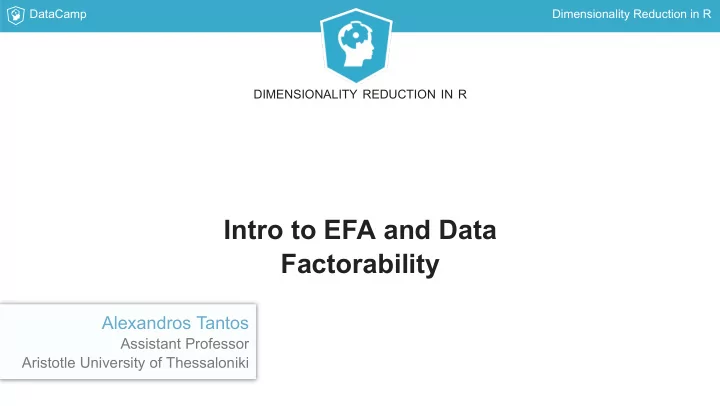

DataCamp Dimensionality Reduction in R DIMENSIONALITY REDUCTION IN R Intro to EFA and Data Factorability Alexandros Tantos Assistant Professor Aristotle University of Thessaloniki
DataCamp Dimensionality Reduction in R EFA: a realistic model for reducing and exploring Variance/covariance are only partially explained by factors Factors are labels for the underlying constructs Causal relationship between factors and observed variables
DataCamp Dimensionality Reduction in R EFA: Measuring the unobserved
DataCamp Dimensionality Reduction in R EFA: Measuring the unobserved
DataCamp Dimensionality Reduction in R EFA: Measuring the unobserved
DataCamp Dimensionality Reduction in R EFA: Measuring the unobserved
DataCamp Dimensionality Reduction in R EFA: Measuring the unobserved
DataCamp Dimensionality Reduction in R EFA: Measuring the unobserved
DataCamp Dimensionality Reduction in R EFA: Measuring the unobserved
DataCamp Dimensionality Reduction in R EFA: Measuring the unobserved
DataCamp Dimensionality Reduction in R EFA: Measuring the unobserved
DataCamp Dimensionality Reduction in R EFA: Measuring the unobserved
DataCamp Dimensionality Reduction in R EFA: Measuring the unobserved
DataCamp Dimensionality Reduction in R EFA: A realistic model of explaining variance
DataCamp Dimensionality Reduction in R Steps to perform EFA Check for data factorability Extract factors Choose the "right" number of factors to retain Rotate factors Interpret the results
DataCamp Dimensionality Reduction in R A first look at the bfi dataset library(psych) data(bfi) # Take a look at the head of bfi dataset. head(bfi)
DataCamp Dimensionality Reduction in R DIMENSIONALITY REDUCTION IN R Let's practice!
DataCamp Dimensionality Reduction in R DIMENSIONALITY REDUCTION IN R Checking for data factorability Alexandros Tantos Assistant Professor Aristotle University of Thessaloniki
DataCamp Dimensionality Reduction in R Steps to perform EFA Check for data factorability Factorability tests: Extract factors The Bartlett sphericity test Choose the "right" number of factors The Kaiser-Meyer-Olkin (KMO) test to retain Rotate factors Interpret the results
DataCamp Dimensionality Reduction in R The Bartlett sphericity test H0: There is no significant difference between the correlation matrix and the identity matrix of the same dimensionality. H1: There is significant difference betweeen them and, thus, we have strong evidence that there are underlying factors.
DataCamp Dimensionality Reduction in R The Bartlett sphericity test library(polycor) # A subset of the bfi dataset. bfi_s <- bfi[1:200, 1:25] # Calculate the correlations. bfi_hetcor <- hetcor(bfi_s) # Retrieve the correlation matrix. bfi_c <- bfi_hetcor$correlations # Apply the Bartlett test. bfi_factorability <- cortest.bartlett(bfi_c) bfi_factorability $chisq [1] 891.1536 $p.value [1] 5.931663e-60 $df [1] 300
DataCamp Dimensionality Reduction in R The Kaiser-Meyer-Olkin (KMO) test for sampling adequacy library(psych) KMO(bfi_c) Kaiser-Meyer-Olkin factor adequacy Call: KMO(r = bfi_c) Overall MSA = 0.76 MSA for each item = A1 A2 A3 A4 A5 C1 C2 C3 C4 C5 E1 E2 E3 E4 E5 N1 0.66 0.77 0.69 0.73 0.75 0.74 0.79 0.76 0.76 0.74 0.80 0.81 0.79 0.81 0.83 0.70 N3 N4 N5 O1 O2 O3 O4 O5 0.82 0.79 0.82 0.79 0.65 0.81 0.62 0.77
DataCamp Dimensionality Reduction in R DIMENSIONALITY REDUCTION IN R Let's practice!
DataCamp Dimensionality Reduction in R DIMENSIONALITY REDUCTION IN R Extraction methods Alexandros Tantos Assistant Professor Aristotle University of Thessaloniki
DataCamp Dimensionality Reduction in R Steps to perform EFA Check for data factorability Extract factors Choose the "right" number of factors to retain Rotate factors Interpret the results
DataCamp Dimensionality Reduction in R Methods for extracting factors EFA aims to: extract factors estimate factor loadings
DataCamp Dimensionality Reduction in R Factor extraction with fa() Extraction methods : minres : minimum residual [default] (slightly modified methods: ols , wls , gls ) mle : Maximum Likelihood Estimation (MLE) paf : Principal Axes Factor (PAF) extraction minchi : minimum sample size weighted chi square minrank : minimum rank alpha : alpha factoring Commonality : First extract the factor that accounts for the most variance, and then successively
DataCamp Dimensionality Reduction in R The minres extraction method library(psych) library(GPArotation) # EFA with 3 factors f_bfi_minres <- fa(bfi_c, nfactors = 3, rotate = "none") # Sorted communality f_bfi_minres_common <- sort(f_bfi_minres$communality, decreasing = TRUE) # create a dataframe for an improved overview data.frame(f_bfi_minres_common)
DataCamp Dimensionality Reduction in R The minres extraction method # Sorted uniqueness f_bfi_minres_unique <- sort(f_bfi_minres$uniqueness, decreasing = TRUE) # create a dataframe for an improved overview data.frame(f_bfi_minres_unique)
DataCamp Dimensionality Reduction in R The MLE extraction method # MLE factor extraction. f_bfi_mle <- fa(bfi_c, nfactors = 3, fm = "mle", rotate = "none") # Sorted communality of the f_bfi_mle. f_bfi_mle_common <- sort(f_bfi_mle$communality, decreasing = TRUE) # create a dataframe for an improved overview data.frame(f_bfi_mle_common)
DataCamp Dimensionality Reduction in R DIMENSIONALITY REDUCTION IN R Let's practice!
DataCamp Dimensionality Reduction in R DIMENSIONALITY REDUCTION IN R Choosing the right number of factors ?lexandros Tantos Assistant Professor Aristotle University of Thessaloniki
DataCamp Dimensionality Reduction in R EFA: How many factors to retain? "Solving the number of factors problem is easy, I do it everyday before breakfast. But knowing the right solution is harder" (Kaiser, 195x). Kaiser-Guttman criterion the Scree test Parallel analysis very simple structure ( VSS ) criterion ( vss() function in psych ) Wayne Velicer’s Minimum Average Partial ( MAP ) criterion ( vss() function in psych )
DataCamp Dimensionality Reduction in R Determining the number of factors: fa.parallel() # Based on the "minres" method. fa.parallel(bfi_c, n.obs = 200, fa = "fa", fm = "minres")
DataCamp Dimensionality Reduction in R Determining the number of factors: fa.parallel() # Based on the "mle" method. fa.parallel(bfi_c, n.obs = 200, fa = "fa", fm = "mle")
DataCamp Dimensionality Reduction in R DIMENSIONALITY REDUCTION IN R Let's practice!
Recommend
More recommend